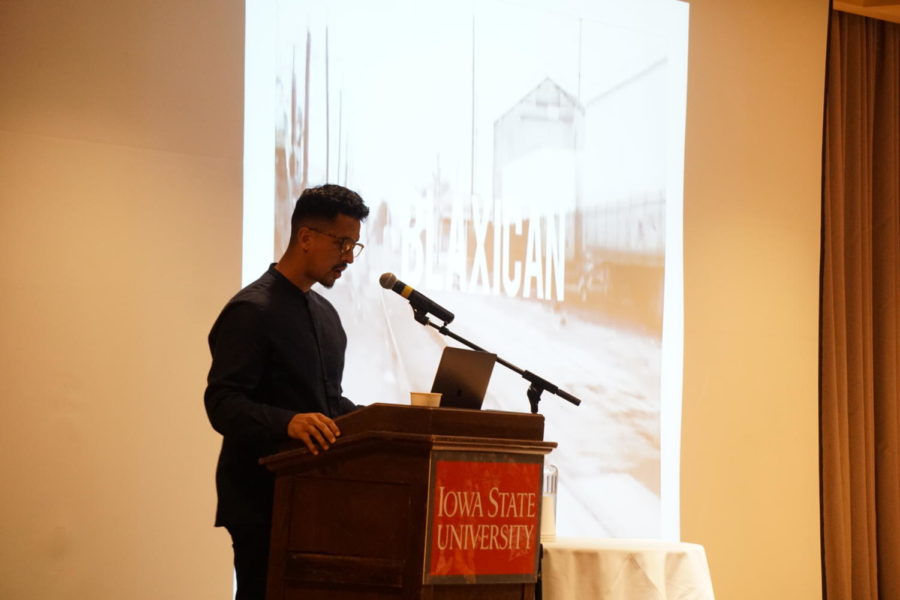New York Times journalist comes to talk about multiracial identity for Black History Month
Megan Petzold/Iowa State Daily
Journalist Walter Thompson-Hernandez came to Iowa State on Feb. 22 to speak to students about what it’s like being multicultural and speaks about how to define ones identity.
February 23, 2018
As the lights went down and as the crowd hushes to a silence, a man gets up and walks to the podium. He opens his laptop and presents a PowerPoint. The first slide presents a graffiti on a blue brick wall in Los Angeles.
The graffiti says “black power, brown pride – Tupac,” which led to the man’s first question.
“What Tupac song is this from?” He asks the crowd.
A student jumps up right away and proudly states the song is “To Live and Die in L.A.”
Walter Thompson-Hernandez, the guest presenting, is shocked, to realize a lecture attendee in Ames was the first to get it right.
Most known for his work called “Blaxicans of L.A.,” where his photos and videos talk about people in South Central Los Angeles and their experience with their multiracial identity of being both black American and Mexican in the United States, Thompson-Hernandez talks about the history of Blaxicans and what could be the future of multiracial identities in the future.
Born in Los Angeles and raised in a poor neighborhood, Thompson-Hernandez had to deal with both of his identities.
He introduced the history of Los Angeles as first being described by Mexicans and as more people started immigrating to the West, more people were pushed into living in isolated communities where drugs and violence became the norm.
“We were at a part of history where there was a lot of racial violence,” Thompson-Hernandez said. “Mexicans who’d just come from the border would hate black people for no reason other than being black and from what they heard from their family.”
He then allowed the audience to see an example by presenting a news story about how students interfered with a Cinco de Mayo assembly after students interrupted a Black History Month assembly. Fights had occurred in the school and the situation was aggravated when the parents got involved.
“I feel like I had to be [black or Mexican], but I really wanted to be both because I love both of my communities,” Thompson-Hernandez said.
He was then inspired to tell stories through different forms of media and wanted to incorporate what is done in academia to allow people to understand other people’s experiences. This led to his most-known work, “Blaxicans of LA,” and other works as well.
Although the term Blaxicans (black-Mexican) is a new term for some, to Thompson-Hernandez, the term is just barely emerging to the general public. As the minority population increases, he states the importance of sharing the stories.
The year 2043 was a theme Thompson-Hernandez focused on. The year is supposedly when white people will be the minority and minorities become the majority, according to the Census Bureau. He expresses this can be feared by some, but to others it’s a sign of hope. This leads him to continue to share his work so others can understand what it means to be multiracial and how this community has impacted the population’s growth.
Thompson-Hernandez also expressed the importance of making academic work more accessible for underrepresented people. He said it is important to share these stories because in academia, there’s a privilege in working on one single question for multiple years and to be able to find solutions to answer these questions.
After the lecture, audience members walked up to the microphone to ask particular questions about Thompson-Hernandez’s work, and his ability to “Crip Walk,” an act of performing quick and intricate footwork.
“How much does economic status play in terms with identity and the conflict between both identities [Black and Mexicans]?” asked a student from the audience.
Thompson-Hernandez responded noting there is a perceived tension created by stereotypes that are placed on both of these communities.
“The base of this tension is on the structural component of society where these communities are lacking in resources like healthcare, welfare and employment,” Thompson-Hernandez said. “[They] play a huge part in the tension that is between these groups.”
The last question came from an adviser of the graduate program asking Thomson-Hernandez how to integrate activism and education into his new current profession as a New York Times journalist.
“How we tell stories today, and the multiple platforms, it makes it easier to share stories and research,” Thompson-Hernandez said. “If academia doesn’t allow its research and findings to be more accessible, then I think academia will struggle in the future.”
Thompson-Hernandez closed by encouraging academics to learn how to speak to the general public in their writing if they want their research to actually inspire and educate the public.







